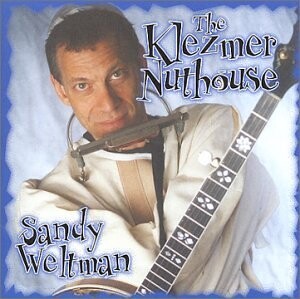 Judith Gennett wrote this review.
Judith Gennett wrote this review.
You may have been told at some point that bluegrass is a genre with rigid rules. Sometimes it is, but the rules have not restricted the musicians of the bluegrass underworld. They also have not restricted St. Louis musician Sandy Weltman, who learned to play banjo in high school to impress a cute girl and launched into bluegrass at a young age. He went on to play in a number of genres, most notably as a jazz harmonicat. As an expression of the soul of his Jewish roots, Weltman (also a devout Christian) devised the Klezmer Nuthouse project, playing along with musicians “most of whom have never played a lick of Klezmer in their lives before this.”
In truth, the all-acoustic The Klezmer Nuthouse is more of a New Acoustic-klez fusion album than a bluegrass-klez album, but the rumors about banjos are true. You can pick out its distinctive sound anywhere and in this case it sets a sort of grassy ambience. Conversely, there is no doubting the klezmer partner, as most of the titles are in Yiddish and most also come from the Klezmer tradition, including some from Abe Schwartz and the great clarinetist Naftule Brandwein. But the many influences Weltman injects and the “Klezmerness” of the tracks vary from track to track.
Looking for a really klezmery selection? The seven minute medley “Ukrainian Etude/Ot Azoi/Tantz Tantz Yidelekh” is ready for dancing, includes tuba, and vocals by Bill Murphy that could be from the Klezmatics. Weltman plays mandolin and harmonica here; the harmonica seems made for klezmer, and the mando is a little less clunky than the banjo. Several tracks later Naftule Bandwein’s “Terkishe yale V’yove Tantz” combines grassy banjo and classical cello, then switches to exotic hand percussion, piano, and harmonica. Weltman seems to have a lot of fun with the harmonica, playing with impressive fluidity and versatility and a lot of jazz-blues influence. He pulls out all the stops on that harmonica on Abe Schwartz’s “Varshavers Freylekhs.” Even though you might not like jazz, you will love … well, probably love … this heavily jazzified and improvised piece with piano, bass,and dumbek.
My own favorite – I actually DO like banjo music! – is Brandwein’s “Fun Taschlach,” played solely by Weltman on a number of instruments including horse sounds. This tune, with distorted banjo notes, is fun and funky as well, but not fortunately silly enough to be unsettling. Another I like is “Dancing Shiek To Shiek.” It is not so flashy and more “progressive” in sound, but is also solely by Weltman. After pondering, I still can’t tell why these production-based tracks are so winsome, except that perhaps they are a little more streamlined, cohesive, and cute. The title track, the nuevo acoustic “The Klezmer Nuthouse” by New Orleans composer Tom McDermott, is pleasant and perky, and includes a bunch of different musicians and instruments, including a rainstick. The actual “bluegrass” piece is “Kishiniever Bulgar” and this is a lot of fun too. This tune points out a real music contrast that can only be discussed by uselessly opening a big musical Pandora’s Box.
The “backing” musicians – actually the rest of the band, since the roles are relatively equal – include Carolbeth True on piano, Dave Black on guitar, Beth Tuttle on the rare vocals, Janice Rieman on cello, Thayne Bradford on violin, and a whole lot of other players. The often improvised arrangements and the band work well together. Good as Sandy Weltman is, he stands out mostly because his instruments are distinctive! The music here isn’t as forceful and vivacious as many of the more conventional klezmer albums; it retains a sense of nuevo acoustic laissez faire. But still The Klezmer Nuthouse should be good listening for klez addicts and of interest to any acoustic music connoisseur.
(Wildstone Audio, 2003)
